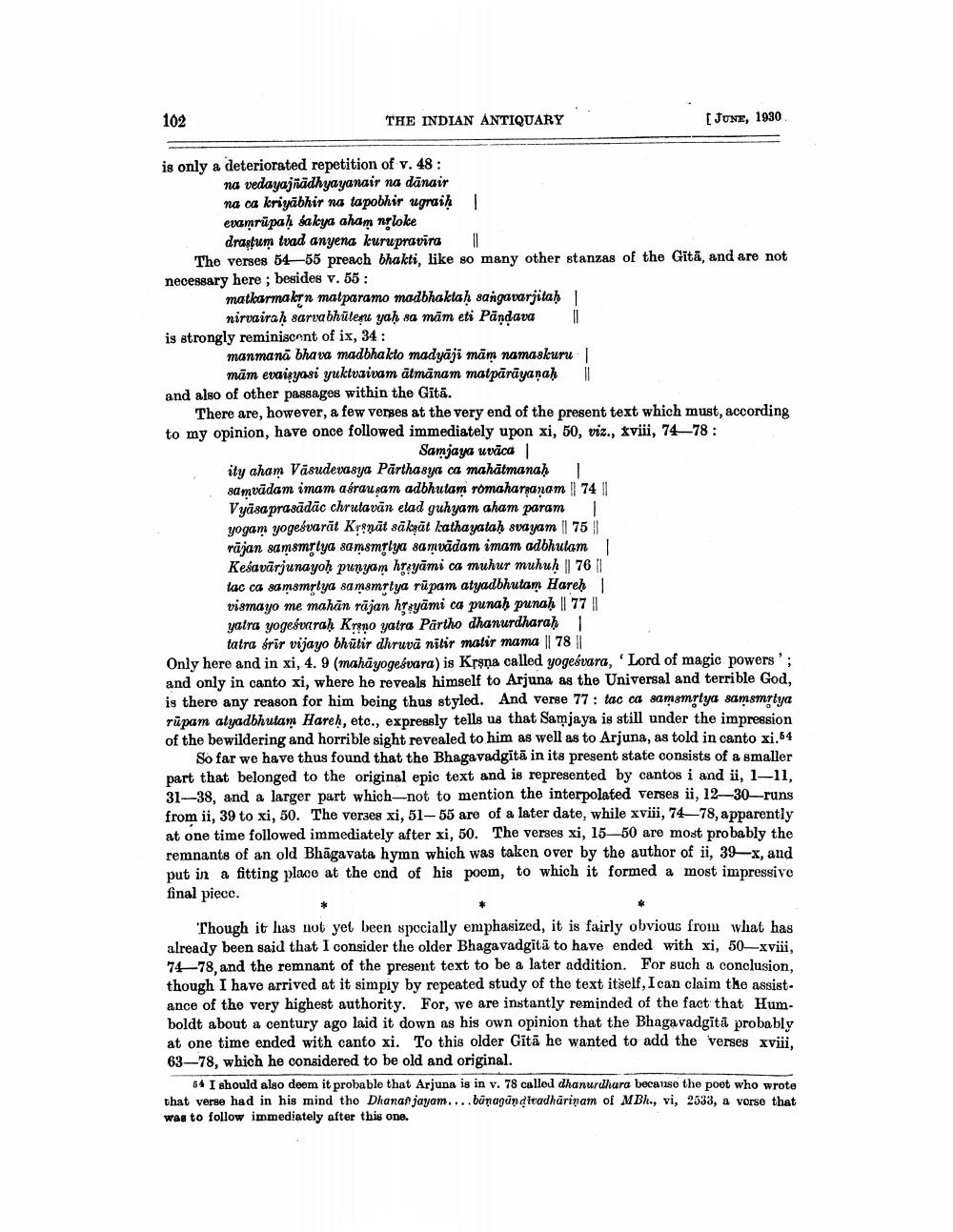________________
102
THE INDIAN ANTIQUARY
JUNE, 1930
is only a deteriorated repetition of v. 48 :
na vedayajiadhyayanair na danair na ca kriyābhir na tapobhir ugraih evamrūpaḥ sakya aham nsloke
drastum tvad anyena kuru pravira ! The verses 54-55 preach bhakti, like so many other stanzas of the Gitā, and are not necessary here ; besides v. 65 :
matkarmakrn matparamo madbhaktah sangavarjitah
nirvairah sarvabhūtenu yah sa mäm eti Pāndava 1 is strongly reminiscent of ix, 34 :
manmanā bhava madbhakto madyāji mām namaskuru
mām evaisyasi yuktusivam ātmānam matpārāyanah | and also of other passages within the Gita.
There are, however, a few verses at the very end of the present text which must, according to my opinion, have once followed immediately upon xi, 50, viz., tviii, 74—78 :
Samjaya uvāca ity aham Vasudevasya Pārthasya ca mahātmanah ! samvādam imam asrausam adbhutam romaharganam | 74 1 Vyāsa prasādāc chrutavan elad guhyam aham param yogam yogesvarät Kyrnāt sākņāt kathayatah svayam || 75 | rūjan samsmrtya 8amsmrtya samvādam imam adbhutam ! Kešavīrjunayoh punyam hayāmi ca muhur muhuh || 76 | tac ca samsmrtya samsmrtya rūpam atyadbhutam Hareh vismayo me mahān rajan hrayami ca punah punah || 77 yatra yogesvairah kreno yatra Partho dhanurdharah 1
tatra Srir vijayo bhūtir dhruva nitir matir mama || 78 || Only here and in xi, 4. 9 (mahayogesvara) is Krşņa called yogeśvara, 'Lord of magic powers'; and only in canto xi, where he reveals himself to Arjuna as the Universal and terrible God, is there any reason for him being thus styled. And verse 77 : tac ca samsmrtya samsmrtya Tūpam atyadbhutam Hareh, etc., expressly tells us that Samjaya is still under the impression of the bewildering and horrible sight revealed to him as well as to Arjuna, as told in canto xi.64
So far we have thus found that the Bhagavadgitā in its present state consists of a smaller part that belonged to the original epic text and is represented by cantos i and ii, 1–11, 31-38, and a larger part which not to mention the interpolated verses ii, 12-30-runs from ii. 39 to xi, 50. The verses xi, 51-55 are of a later date, while xviii, 74–78, apparently at one time followed immediately after xi, 50. The verses xi, 15–50 are most probably the remnants of an old Bhagavata hymn which was taken over by the author of ii, 39x, and put in a fitting place at the end of his poem, to which it formed a most impressive final piece.
Though it has not yet been specially emphasized, it is fairly obvious from what has already been said that I consider the older Bhagavadgitā to have ended with xi, 50–xvii, 7478, and the remnant of the present text to be a later addition. For such a conclusion, though I have arrived at it simply by repeated study of the text itself, I can claim the assist. ance of the very highest authority. For, we are instantly reminded of the fact that Humboldt about a century ago laid it down as his own opinion that the Bhagavadgitā probably at one time ended with canto xi. To this older Gītā he wanted to add the verses xviii, 63–78, which he considered to be old and original.
54 I should also doem it probable that Arjuna is in v. 78 called dhanurdhara because the poet who wrote that verse had in his mind tho Dhanaf jayam....bunagundiradharinam of MBI., vi, 2533, a vorse that was to follow immediately after this one.




